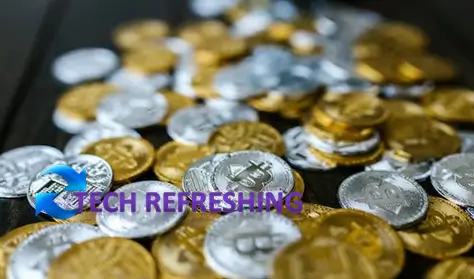Definition of Stable Coins
Stable coins are a revolutionary innovation in the world of cryptocurrencies that aims to provide price stability. Unlike traditional cryptocurrencies like Bitcoin, which are renowned for their volatile nature and unpredictable value, stable coins are pegged to a specific asset or a basket of assets, allowing them to maintain a consistent value. This often means stable coins are pegged to the value of a fiat currency such as the US dollar, providing users with the assurance of stability and predictability in terms of value. With the stability offered by stable coins, individuals and businesses alike can transact and invest with confidence, knowing that the value of their assets won’t experience wild fluctuations.
Importance of Stable Coins in Enabling Borderless Transactions
The popularity of stable coins has paved the door for borderless transactions, which let people to send and receive money without being constrained by national boundaries. Due to the consistent value of the money regardless of where it is spent, stable coins enable frictionless cross-border transactions. This avoids the requirement for currency exchange, which may be both costly and time-consuming.
Moreover, the adoption of stable coins enables direct, intermediary-free cross-border transactions. This results in reduced transaction costs and quicker payment processing, making stable coins a desirable choice for individuals or organizations engaging in global financial transactions.
The Problem with Traditional Currency Transactions
High Transaction Fees
One of the paramount difficulties associated with conventional currency transactions is the exorbitant transaction fees that are frequently imposed by banks and other middlemen. These fees can be substantial, particularly when it comes to transmitting or receiving payments across international borders. For instance, an average international wire transfer can result in fees as high as 10% or even more, rendering it a costly choice for individuals seeking to send or receive money globally.
Slow Transfer Times
A further issue with traditional currency transactions is the sluggish transfer pace. Transactions that include currency conversion or cross-border transfers may take a considerable number of days to be processed. This can pose a significant hindrance for those who require swift access to their money, as they may need to endure a waiting span of several days before they can make use of the funds.
Exchange Rate Fluctuations
A further challenge posed by traditional currency transactions is the instability of exchange rates. The worth of a currency can fluctuate rapidly, creating difficulties for individuals who wish to transmit or receive payments across international borders. This is particularly true for those executing substantial transactions, as even a minor fluctuation in the exchange rate can result in a substantial impact on the value of their funds.
The issues with traditional currency transfers include high transaction costs, lengthy transfer periods and exchange rate changes, which can make it challenging and expensive for consumers wishing to transact internationally. Stable coins, which provide a more effective, quick and economical way to transact globally, are one alternative that have seen increasing demand as a result of these problems.
How Stable Coins Solve the Problems with Traditional Currency Transactions

Low Transaction Fees
One of the key benefits of stable coins is their low transaction fees. Since stable coins are based on blockchain technology, they can be transmitted and received without the need for intermediaries such as banks. This significantly reduces the transaction fees compared to traditional currency transactions. In many cases, stable coin transactions can be completed at a fraction of the cost of traditional methods, making them an attractive option for those looking to send or receive money globally.
Fast Transfer Times
Fast transfer times are another benefit of stable currency. In contrast to the several days it may take for traditional currency transactions to be processed, transactions can be done in a matter of seconds or minutes. Because of their near-instantaneous cash access, stable coins are the perfect alternative for those who need to pay or receive money fast.
Stable Exchange Rate
One of the key advantages of stable coins is their stable exchange rate. Stable coins are linked to the value of a designated asset or a combination of assets, leading to their value remaining constant and unaffected by market changes. This effectively eradicates the possibility of exchange rate fluctuations, which can have a substantial effect on the worth of funds during cross-border transactions.
Stable coins address the challenges posed by traditional currency transactions by presenting low transaction fees, quick transfer speeds and a steady exchange rate. These advantages make stable coins a more efficient, fast and cost-effective alternative to conventional currency transactions, making it an attractive choice for individuals seeking to transact globally.
Advantages of Using Stable Coins for Borderless Transactions

Access to Global Markets
One of the key advantages of using stable coins for borderless transactions is the ability to access global markets. With stable coins, individuals and businesses can transact globally without the need for intermediaries, such as banks. This enables them to take advantage of new opportunities, expand their reach and access new markets, regardless of where they are located.
Ease of Use for Cross-Border Payments
Another merit of stable coins is their simplicity in facilitating cross-border payments. Stable coins allow for swift and effortless transmission and receipt, without the need for cumbersome paperwork or other bureaucratic formalities. This makes them a optimal solution for individuals who seek to transact globally, as they can readily and easily access their funds and make payments to others, regardless of their location.
Increased Security through Blockchain Technology
Stable coins operate on blockchain technology, offering increased security compared to traditional currency transactions. Blockchain technology is a decentralized ledger system that boasts exceptional security, making it difficult for malicious actors to manipulate the data stored on the network. This makes stable coins a safer option for individuals who seek to transact globally, as they can have peace of mind knowing their funds are protected.
In summary, the advantages of using stable coins for borderless transactions include access to global markets, ease of use for cross-border payments and increased security through blockchain technology. These benefits make stable coins an attractive option for individuals and businesses looking to transact globally, as they offer a more efficient, fast and secure way to transact.
Real-World Examples of Stable Coins in Action
Remittances
A noteworthy practical application of stable coins is in the realm of remittances. Remittances refer to money transfers made by individuals to their family and friends in foreign countries. Stable coins have emerged as a favored solution for remittances, offering low transaction fees, speedy transfer speeds, and a steady exchange rate. This has made it simpler and more economical for people to send funds to their loved ones, no matter their location.
E-commerce
Another practical utilization of stable coins is in the e-commerce sector. Stable coins are employed by e-commerce platforms to offer fast, secure and economical cross-border payments. This is particularly beneficial for businesses with a global presence, as it allows them to tap into new markets, broaden their reach and boost their sales. Furthermore, stable coins are also used by e-commerce platforms to facilitate micropayments, transactions that are too small to be processed by conventional payment methods.
International Transfers
Stable coins are also playing a role in streamlining international transfers, making it easier and more cost-effective for both individuals and businesses to transact globally. Such transfers can be accomplished rapidly and effortlessly, without the involvement of intermediaries such as banks. This has made it more accessible and affordable for people to send and receive money globally, regardless of their location. Furthermore, stable coins have been utilized to mitigate the risks posed by currency fluctuations, as their value remains constant and unchanging in the face of market fluctuations.
In summary, real-world examples of stable coins in action include remittances, e-commerce, and international transfers. These examples demonstrate the significant benefits of stable coins for enabling borderless transactions, as they offer a fast, secure, and affordable way to transact globally.
Future of Stable Coins and Borderless Transactions

Growth of Decentralized Finance (DeFi)
The future of stable coins and borderless transactions is closely tied to the growth of decentralized finance (DeFi). DeFi refers to financial applications and services that are built on blockchain technology and operate without intermediaries. Stable coins play a critical role in the growth of DeFi, as they are used to facilitate fast, secure and affordable transactions. The growth of DeFi is likely to drive the adoption of stable coins, as more people become aware of the benefits of decentralized financial services.
Integration with Traditional Financial Systems
The future of borderless transactions is anticipated to be significantly influenced by the integration of stable currencies with conventional finance. Stable coins provide quicker, more secure, and more affordable alternatives to traditional money transactions, offering a revolutionary option. Stable coins are anticipated to be progressively incorporated into traditional finance as they become more widely used, making it simpler for consumers to interact internationally.
Increased Adoption of Stable Coins
The future of stable coins and borderless transactions is also likely to be shaped by increased adoption of stable coins. As more people become aware of the benefits of stable coins, such as low transaction fees, fast transfer times, and a stable exchange rate, they are likely to become more widely adopted. This increased adoption is likely to drive the development of new stable coin-based services and applications, further expanding the reach and impact of stable coins.
In summary, the future of stable coins and borderless transactions is likely to be shaped by the growth of DeFi, the integration of stable coins with traditional financial systems and increased adoption of stable coins. These trends are likely to drive the development of new stable coin-based services and applications, further expanding the reach and impact of stable coins and enabling borderless transactions.
Here are some commonly used stable coins:
Conclusion
In this blog post, we have discussed the importance of stable coins in enabling borderless transactions. Stable coins offer a number of benefits over traditional currency transactions, including low transaction fees, fast transfer times and a stable exchange rate. Additionally, stable coins have also been used to facilitate remittances, e-commerce and international transfers, demonstrating the real-world benefits of stable coins for enabling borderless transactions.
Final Thoughts on the Future of Stable Coins and Their Impact on the Financial Industry
The future of stable coins and borderless transactions is likely to be shaped by the growth of DeFi, the integration of stable coins with traditional financial systems and increased adoption of stable coins. These trends are likely to drive the development of new stable coin-based services and applications, further expanding the reach and impact of stable coins and enabling borderless transactions.
In conclusion, stable coins have the potential to revolutionize the financial industry by enabling borderless transactions and providing a fast, secure and affordable alternative to traditional currency transactions. As stable coins continue to gain popularity and become more widely adopted, it is clear that they will have a significant impact on the financial industry and the way we transact globally.
Crypto Disclosure:
This blog post is intended to provide general information about stable coins and how they are enabling borderless transactions. The information contained in this blog post is not intended as investment advice and should not be relied upon as such. The value of stable coins can be volatile and their performance in the past is not indicative of future performance. It is important to conduct thorough research and seek professional advice before making any investment decisions.



Comments are closed.